|
|
|
|||
|
|
||||
|
|
||||
| The Smoky Addiction | ||||
|
|
HOME | SITE MAP | FORUM | CONTACT |
|
||
|
ABOUT | MOTORS | MODELS | ARCHIVE | HISTORY | STORE | BACK ROOM | LINKS
|
|
|
|
|
|
|||||||||||||||||||||||||||||||||||||||||||||||||||||||||
 The Smoky Addiction 1
(January 2005)
The Smoky Addiction 1
(January 2005)by Roger Simmonds Reprinted from SAM 35 Speaks, January 2005 First, welcome to the restyled column, which I hope will satisfy readers’ cravings for all things reactionary. I hope you like the title, which was (inevitably) first coined by Stan Pearson. I did wonder whether ‘addiction’ was apposite, but flying small free flight jet models is an irrational obsession: why else, after all, would we do it? Last month we saw the return of ‘Jetex Jim’ and the introduction of ‘Rocky Rapier’. JJ appeared happy with his new paramour, but it may be asked what happened to an erstwhile lady friend of his who made a brief appearance in the December 1953 Aeromodeller (see top right). Jetex Jemima, as I think she should be called, now seems to be making advances to Rocky, who is mulling things over and getting himself into a bit of an ‘L4 lather’, which is the rate at which he may need to go if Jim ever finds out. Enough of this New Year nonsense! It will be admitted, though, that the fifties’ adverts had an innocence and a certain whimsical appeal (well to me anyway) far removed from today’s homogenised computer-generated offerings. And now to business, spearheaded by Graham Potter’s Javelin. This is not, as I had thought, the 1953 KeilKraft design, but Ray Booth’s very nice Skyleada offering. Graham writes: |

- Aeromodeller , Dec. 1953
|
|||||||||||||||||||||||||||||||||||||||||||||||||||||||||
|
“The original small black Javelin was odd. It would fly perfectly one flight only to turn in (either way) the next. The best flight it ever did was very large circles at about 25 feet on a very low powered L1. This led me to believe that it was overpowered. I’m of the opinion (with no proof) that most of us overpower these jets. They fly so fast that that they become susceptible to the slightest aerodynamic imbalance, such as a bit of slack tissue etc. This [view] was given more credence by the low powered flights of my largish Venom and latterly by Mike Stuart’s Mystère. Anyway, the new Javelin is 11.5 old fashioned inches span with a weight as yet unknown. The idea is to fly on an L2 LT. I had incorporated some reflex on the smaller one, but I have reduced it on the larger one, the intention is to fly it more ‘on the tailplane’ so to speak. We will see.” Graham’s comments about “reflex” and “flying on the tailplane” are worth some reflection. The ‘tailed delta’ is a questionable concept: an operational tail can be blanketed at certain angles of attack, often when it is needed most; if the wing is reflexed the tail is redundant and merely produces drag. The configuration did not gain wide acceptance in full size aviation; there was the Gerfaut, the F.D.1 and the Boulton Paul 120, but it’s hard to think of an example other than the Javelin that actually reached the squadrons and didn’t remain experimental. The text accompanying the very tasty model illustrated above (which featured in ‘Delta Model News’, Aeromodeller, May 1953) reads: “This model uses a reflex section, and the high mounted tailplane should be quite helpful in encouraging the Delta to a useful flying attitude”. I wonder. |
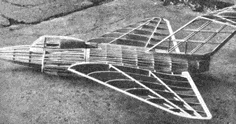
- Aeromodeller , May 1953
|
|||||||||||||||||||||||||||||||||||||||||||||||||||||||||
|
|
|
|||
|
Bert Judge made a prototype ‘Tailored’ Javelin as a companion to the Jetmaster Hunter and Swift. The wing was not reflexed. This was a comparatively large model (24" span) that, uniquely, had a representation of the twin jet nozzles at the end of the augmenter tube. The model proved too draggy for the Jetmaster; a Scorpion was not considered an option, and the prototype never became a kit. A great pity. The ‘tailed delta’ was not confined to scale designs, and a most curious 22" twin-finned ‘free flight duration’ design, K. Brown’s ‘Dartex’ for Jetex 100, was published in Model Aircraft, March 1954. 
The flat-bottomed wing is in effect reflexed by the use of hinged elevons. According to Mr Brown’s trimming notes, these ‘were adjusted for a satisfactory glide’, but this needed to be done very carefully, as they were extremely sensitive. I wonder what he thought the tailplane was supposed to be doing. Would the model have performed better without the tailplane? A Rapier version might make an interesting experiment; the sensitivity Brown emphasises was probably due to it being overpowered. Though designed for the Jetex 50, the contemporaneous Delta Jet P 30 by Jacques Peguillan (see SAM Yearbook 13) had a larger delta wing of 24" span. Sporting just a single fin and no tailplane, it is an altogether more competent design that should go very well with an L2. |

- Mike Ingram

- Model Aircraft, March 1954
|
|||
|
Whilst on the subject of deltas, tailed or otherwise, the L.S.A.R.A proposed a radio controlled delta [right] whose conception was very similar to those of our old friend ‘Commander’ Benson-Ball. This ambitious project, which is only just a little more believable than some of BB’s flights of fancy, appeared in ‘The Delta Wing’ by J A Fozard, (Aeromodeller, March 1953). It was built not by the Jetex team, but by R J Balmer and Fozard himself, who published quite widely on deltas at this period. Fozard reported: “Drawings and a full size mock- up appeared at the 1952 M E Exhibition. A four channel proportional control radio receiver is to be carried […] power is provided by eight [!] specially boosted Jetex 350 motors in two clusters of four. These exhaust into 3" diameter jet pipes which are ducted forward to the twin wing root intakes, giving, it is hoped, a considerable degree of augmentation.” At 64" length and a weight of 6 lbs, it would have needed at least two pounds of thrust. No fewer than six are claimed; they must have been very special 350 motors indeed. A more practicable model (right) was also discussed in Fozard’s article: “[the] semi blended delta for Jetex 100 is a small scale version of [the] LSARA project. Span 16 in. Weight 2¼ oz. Area 95 sq. in. Airspeed 30 mph”. This looks a much more reasonable proposition, and recreation from the 3-view shouldn’t be too difficult. Incidentally, I loved the ‘airspeed 30 mph’ bit: these sorts of spurious data were quite common in the magazines of the time. With over an ounce of thrust and a span of just 16" it must have been a very lively flier indeed. I wonder how its airspeed was estimated. There was a Javelin in the Wilmot Mansour ‘Tailored Silhouette’ series (see right). These models, all designed by Mike Ingram for the Jetex 50, had a reputation as good fliers. Richard Woods reminisces: “The profile Javelin was exceptionally effective. With scratch-built and sectioned wings (very light balsa thinly cambered) it could be induced with elevator to do a full loop off a soft hand launch into a light breeze and recover with about 20 feet of air still under it. These were mostly 100s and 150s. Sticking two either side of a larger but still profile Javelin did not work. If we got them started evenly enough it merely flew like a rocket and then stalled horribly. Adding weight to beat the stall killed the whole idea!” Note that Richard modified the wing section from a flat plate. The ‘Silhouette’ Javelin was featured in SAM Speaks some years ago; I can copy the components for anyone who wants to make a replica for Rapier. Rapier Regeneration |
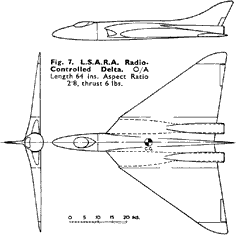
- Aeromodeller, March 1953
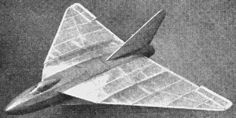 (scaled from L.S.A.R.A. proposed delta)
- Aeromodeller, March 1953
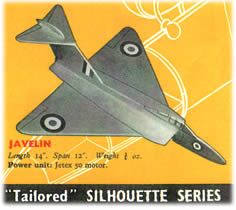 Jetex ‘Silhouette’ Javelin, by Mike Ingram
- Jetex brochure, c. 1953
|
|||
|
I recently went flying with Howard Metcalfe at Middle Wallop, and we had a splendid time – quite the best flying day of the year for me – and the weather was mild and calm, if with a slight hint of precipitation in the air. Howard’s motors did not seem to be providing the expected oomph; he remarked that he had stored them in an intermittently heated bedroom, though he had put the boxes above a radiator the day before. This might not have been enough to dry them through, as he found during ‘core boring’ (a necessary preflight preliminary these days) that the consistency of the propellant was quite ‘putty like’. My motors seemed to be provide the expected thrust, but the L2 LTs were, I suspect, even harder to ignite than usual. Andrew Longhurst contacted me after November’s maunderings about Rapier motors’ susceptibility to the cold and damp: “I bought a load of L2 HPs a year ago and kept them in the garage. They all took on water and swelled, bursting their cases. Do you think the HP is more susceptible to gaining moisture from the atmosphere than the lesser puff ones? I have never used the others so I don't know. All I do know is that it was an expensive lesson. How can we keep them in an ultra dry atmosphere? Put them in sealed tin with silica gel?” I certainly advise storing Rapiers in a tin with silica. I don’t know if L2 HPs are more hygroscopic than standard motors, but we do have evidence that they are more temperamental and variable (see later). Jetex pellets are perhaps not as moisture resistant as I had thought, and dedicated contest fliers used to dry their fuel quite carefully. I don’t think they aimed for complete desiccation, as some water turning to steam could boost the thrust, so an optimum water content, not easy to achieve, was the aim. The drying process could go spectacularly wrong. Mike Ingram reminisces about an incident at Jetex. “I put a wire grille from an oven on top of an electric hot plate with lots of Jetex fuel on it, to dry it out to dehydration level. The grille sagged under the weight. This caused an emergency evacuation of the factory when the neglected fuel pellets dried out a little too well and set, off causing billowing clouds of white smoke flooding the factory. Fortunately there was about eighteen inches of free air near the floor for people to breathe as they crawled out on their hands and knees.” A salutary tale indeed: we have been warned! Graham Potter has a made a brace of Rapier powered ‘West Wing’ Hmm. Perhaps I too was sent a duff batch of these supposedly ‘high power’ motors and their inadvertent soaking courtesy GPO had less effect on their dismal performance than I had thought. Not that it could have helped, mind you. Terry Kidd tells me he also had a batch of Rapiers left on the doorstep open to the elements, and now requests his favoured supplier to pack motors so they can negotiate your average letter box. Two Jet X-Planes The first ‘X-Plane’ is a ‘Classic’ plan, courtesy of Richard Crossley, that has been neither published nor (says Richard) built before: Reg Boor’s 1954 Douglas X-3 Stiletto for Jetex 50 [below]. Richard stored the plan in a safe place for many years after Reg had passed it to him, and serendipitously found it recently when ‘sorting out’ after his house move. Knowing my interest in this early plan of a real turkey, he passed it to me. It has survived really quite well, being complete with all formers, stringer positions etc (not shown in the compilation below) and should present few difficulties to an experienced rocketeer. 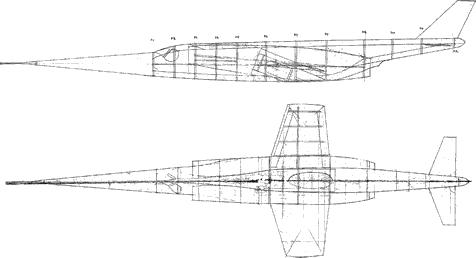 Whether he could get it to fly is another matter. The span is 7¼" for a length of 21", equating to an S/L of 0.35. The Starfighter has an S/L of 0.43 (see (Jet)X Files May 2003); the X-3 is even more etiolated, and prototype, it will be remembered, was prone to ‘roll coupling’ at the slightest provocation. A model may well exhibit the same alarming tendencies. However, the wing area is about |
||||
|
The second ‘X-plane’ is perhaps even more challenging. After seeing December’s column and SpaceShipOne, Alan Wiggs, who may be in league with Stan Pearson, sent me details of the flight of the X-43A scramjet, which recently achieved Mach 10 at 110,000 ft for ninety seconds. I think Alan wondered what a model rocket-plane flier would make of it. Well, the altitude is a bit extreme, the speed not too unreasonable (our scale models can fly at what appears close to that speed), but the ‘ninety seconds’ is of course all but impossible for a ‘Jetex’ scale ship! Seriously, the X-43 would make a fascinating project, and not quite as impossible as one might think – though I wouldn’t advise a profile model – and if built light, it might go quite nicely from a catapult launch Stability should not be a problem: it just needs plenty of reflex. |

- Jay Miller, The X-Planes, X-1 to X-45, 3rd ed., Midland Publishing 2001
|
|||
|
|
||||
|
|
|
|||
|
|
|
|
|
|
|
|
Acknowledgements - Article: Roger Simmonds - Illustrations: Roger Simmonds, Richard Crossley, Mike Ingram, MAAC archives via Bill Henderson |
|
|
|
|
ABOUT | MOTORS | MODELS | ARCHIVE | HISTORY | STORE | BACK ROOM | LINKS |
|
|
Terms of Use
|
Queries? Corrections? Additions?
Please
contact us.
|
|